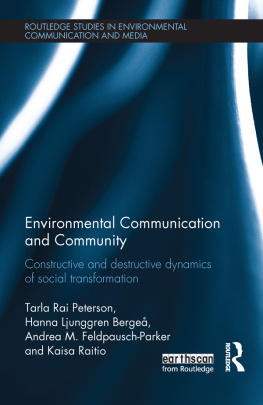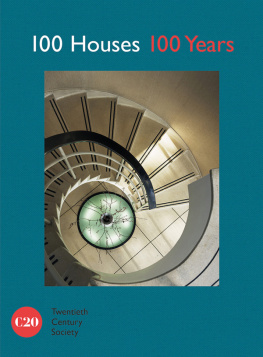T HE H OUSING B OMB
THE HOUSING BOMB
W HY O UR A DDICTION TO H OUSES I S D ESTROYING THE E NVIRONMENT AND T HREATENING O UR S OCIETY
M. Nils Peterson, Tarla Rai Peterson, and Jianguo Liu

2013 The Johns Hopkins University Press
All rights reserved. Published 2013
Printed in the United States of America on acid-free paper
2 4 6 8 9 7 5 3 1
The Johns Hopkins University Press
2715 North Charles Street
Baltimore, Maryland 21218-4363
www.press.jhu.edu
Library of Congress Cataloging-in-Publication Data
Peterson, M. Nils, 1976
The housing bomb : why our addiction to houses is destroying the environment and
threatening our society / M. Nils Peterson, Tarla Rai Peterson, Jianguo Liu.
pages cm
Includes bibliographical references and index.
ISBN-13: 978-1-4214-1065-4 (hardcover : alk. paper)
ISBN-13: 978-1-4214-1066-1 (electronic)
ISBN-10: 1-4214-1065-6 (hardcover : alk. paper)
ISBN-10: 1-4214-1066-4 (electronic)
1. HousingEnvironmental aspectsUnited States. 2. Housing development
Environmental aspectsUnited States. 3. Human ecologyUnited
States. 4. Urban ecology (Sociology)United States. 5. Ecological houses
United States. 6. Sustainable urban developmentUnited States. I. Peterson,
Tarla Rai. II. Liu, Jianguo, 1963 III. Title.
HD7293.P424 2013
363.540973dc23 2012051093
A catalog record for this book is available from the British Library.
Special discounts are available for bulk purchases of this book. For more information,
please contact Special Sales at 410-516-6936 or specialsales@press.jhu.edu.
The Johns Hopkins University Press uses environmentally friendly book materials,
including recycled text paper that is composed of at least 30 percent post-consumer
waste, whenever possible.
Contents
ACKNOWLEDGMENTS
Many people contributed to this book, but we are most indebted to our family members, especially Shannon Peterson, who read endless drafts. Other family members who inspired us, gave us time to write, and provided valuable feedback include Gwen Peterson, Markus Peterson, Scott Peterson, Wayne Peterson, David Williams, Kenneth Powers, Qiuyun Wang, Julie Liu, and Jessica Liu.
Our colleagues in the Triangle Urban Long Term Research Area, the Center for Systems Integration and Sustainability, and the Human Dimensions of Fisheries, Wildlife, and Conservation Biology lab were instrumental in forming many ideas presented in this book. Students in the Communication Department at the University of Colorado, Boulder, asked hard questions about our suggestions for defusing the housing bomb. They pushed us to provide evidence that individuals can make a difference. Colleagues who offered ideas and constructive criticism include Cristin Alarcn, Danielle Endres, Jennie Stephens, and Elizabeth Wilson. Three anonymous reviewers provided crucial feedback and suggestions for improving the book. We received critical institutional support from Chris Moorman and Barry Goldfarb in the Department of Forestry & Environmental Resources at North Carolina State University, Michigan State University, the Environmental Communication Program at the Swedish University of Agricultural Sciences, and Texas A&M University. We thank all students and collaborators for many years of productive collaborations on research in the Wolong Nature Reserve, especially Zhiyun Ouyang of the Chinese Academy of Sciences and Hemin Zhang of the Wolong Nature Reserve, as well as Wolong residents for the opportunities to interview them.
Research presented in this book was funded by the National Science Foundation (Urban Long Term Research Area; Dynamics of Coupled Natural and Human Systems; Partnership for International Research and Education; and Science, Technology, and Society Program), the National Aeronautics and Space Administration, the National Institutes of Health, the U.S. Forest Service (Urban Long Term Research Area), and the North Carolina Department of Environment and Natural Resources (Urban and Community Forestry Grants).
Finally, we must thank the Johns Hopkins University Press. Notably, Vincent Burke and copyeditor Kathleen Capels are as passionate about the subject as we are. They far exceeded our expectations in their enthusiasm for improving the manuscript as we revised it.
T HE H OUSING B OMB
I NTRODUCTION
The world is facing a housing bomb that will make the 2007 subprime mortgage crisis look trivial. Public attention focused on this housing bomb has been limited, with much greater emphasis having been placed on the environmental impacts of human population. Although the population problem has deep historical roots, Paul Ehrlich brought the idea to the masses in his ground-breaking book, The Population Bomb (1968), where he suggested that the human population was a bomb waiting to explode in an apocalyptic scenario of warfare, economic crashes, and mass starvation. He wrote, In the 1970s, the world will undergo famines. Hundreds of millions of people are going to starve to death in spite of any crash programs embarked upon now. Fear generated by this prophecy gripped many among the emerging environmental movement. Fortunately, although political strife, poverty, and violence have combined with overpopulation to create regional famines, global collapse has not yet occurred.
This unexpected and fortuitous turn of events, however, can be explained by Ehrlichs own work. He argued that humans impact on the environment was the product of human population, affluence (per capita consumption), and technology. When the human population exploded, technology and affluence prevented the predicted apocalyptic end of human society. Relatively affluent societies used their excess capital (natural resources, labor, knowledge, and money) to drive the green revolution and the ensuing biotech revolution, both of which dramatically increased crop yields and created the food surpluses needed to reduce hunger rates in the face of rapid population growth.
In fact, environmentalists were faced with a paradox. While most indicators of ecological health have declined rapidly since 1960, most indicators of humans quality of life have improved just as drastically.
Decisions to have a first child often revolve around psychological rationales (e.g., having a child to love), but decisions to have a second child, a step in avoiding rapid population declines, pertain to family building (e.g., having both a boy and girl). If immigrants are excluded from population calculations, every nation that has successfully provided food and social security for its citizens has a stable or declining human population. Some minority cultural and religious groups provide small-scale exceptions, but even Catholic Italy has had a fertility rate of less than 1.5 children per woman since the early 1980s, and that would lead to rapid population declines without immigration.
Unlike children, however, houses are an addiction. While rising affluence and human well-being defused the population bomb, the same factors only whet our appetite for more houses, larger houses, houses on bigger pieces of land, and houses in beautiful natural landscapes. The factors that defused the population bomb built the housing bomb.
How Society Made the Housing Bomb
When people find social security and replace their investment in children with an investment in stuff, they invest in houses. Although population growth is stabilizing and even declining in many areas (such as regions of ).
The housing bomb is different from the population bomb, because human society has chosen to invest technology and excess capital in making the housing bomb bigger, rather than defusing it, as happened with the population bomb. People in wealthy countries dont invest their excess capital in making homes smaller, or in locating them in places with little environmental impact, and they far too rarely invest in making houses more efficient. Governments have also done their part to promote home ownershipand its accompanying sprawlthrough the establishment of various fiscal and regulatory policies and institutions (see Home proliferation poses a severe threat to the environment, and to the survival of a world that can continue to support human life.
Next page










